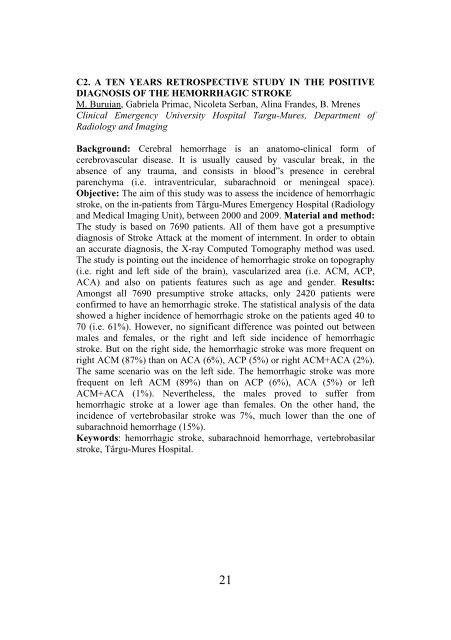Sovata - Societatea de Radiologie şi Imagistică Medicală din România
Sovata - Societatea de Radiologie şi Imagistică Medicală din România
Sovata - Societatea de Radiologie şi Imagistică Medicală din România
You also want an ePaper? Increase the reach of your titles
YUMPU automatically turns print PDFs into web optimized ePapers that Google loves.
C2. A TEN YEARS RETROSPECTIVE STUDY IN THE POSITIVE<br />
DIAGNOSIS OF THE HEMORRHAGIC STROKE<br />
M. Buruian, Gabriela Primac, Nicoleta Serban, Alina Fran<strong>de</strong>s, B. Mrenes<br />
Clinical Emergency University Hospital Targu-Mures, Department of<br />
Radiology and Imaging<br />
Background: Cerebral hemorrhage is an anatomo-clinical form of<br />
cerebrovascular disease. It is usually caused by vascular break, in the<br />
absence of any trauma, and consists in blood”s presence in cerebral<br />
parenchyma (i.e. intraventricular, subarachnoid or meningeal space).<br />
Objective: The aim of this study was to assess the inci<strong>de</strong>nce of hemorrhagic<br />
stroke, on the in-patients from Târgu-Mures Emergency Hospital (Radiology<br />
and Medical Imaging Unit), between 2000 and 2009. Material and method:<br />
The study is based on 7690 patients. All of them have got a presumptive<br />
diagnosis of Stroke Attack at the moment of internment. In or<strong>de</strong>r to obtain<br />
an accurate diagnosis, the X-ray Computed Tomography method was used.<br />
The study is pointing out the inci<strong>de</strong>nce of hemorrhagic stroke on topography<br />
(i.e. right and left si<strong>de</strong> of the brain), vascularized area (i.e. ACM, ACP,<br />
ACA) and also on patients features such as age and gen<strong>de</strong>r. Results:<br />
Amongst all 7690 presumptive stroke attacks, only 2420 patients were<br />
confirmed to have an hemorrhagic stroke. The statistical analysis of the data<br />
showed a higher inci<strong>de</strong>nce of hemorrhagic stroke on the patients aged 40 to<br />
70 (i.e. 61%). However, no significant difference was pointed out between<br />
males and females, or the right and left si<strong>de</strong> inci<strong>de</strong>nce of hemorrhagic<br />
stroke. But on the right si<strong>de</strong>, the hemorrhagic stroke was more frequent on<br />
right ACM (87%) than on ACA (6%), ACP (5%) or right ACM+ACA (2%).<br />
The same scenario was on the left si<strong>de</strong>. The hemorrhagic stroke was more<br />
frequent on left ACM (89%) than on ACP (6%), ACA (5%) or left<br />
ACM+ACA (1%). Nevertheless, the males proved to suffer from<br />
hemorrhagic stroke at a lower age than females. On the other hand, the<br />
inci<strong>de</strong>nce of vertebrobasilar stroke was 7%, much lower than the one of<br />
subarachnoid hemorrhage (15%).<br />
Keywords: hemorrhagic stroke, subarachnoid hemorrhage, vertebrobasilar<br />
stroke, Târgu-Mures Hospital.<br />
21


